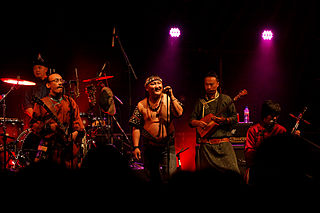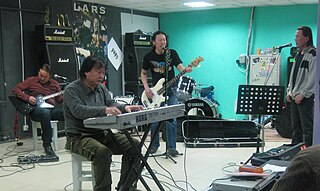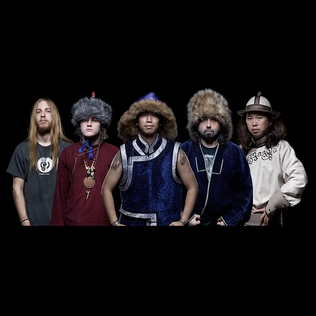Related Research Articles
Kyrgyz music is nomadic and rural, and is closely related to Turkmen and Kazakh folk forms. Kyrgyz folk music is characterized by the use of long, sustained pitches, with Russian elements also prominent.

Music is an integral part of Mongolian culture. Among the unique contributions of Mongolia to the world's musical culture are the long songs, overtone singing and morin khuur, the horse-headed fiddle. The music of Mongolia is also rich with varieties related to the various ethnic groups of the country: Oirats, Hotogoid, Tuvans, Darhad, Buryats, Tsaatan, Dariganga, Uzemchins, Barga, Kazakhs and Khalha.

The morin khuur, also known as the horsehead fiddle, is a traditional Mongolian bowed stringed instrument. It is one of the most important musical instruments of the Mongol people, and is considered a symbol of the nation of Mongolia. The morin khuur is one of the Masterpieces of the Oral and Intangible Heritage of Humanity identified by UNESCO.

The culture of Mongolia has been shaped by the country's nomadic tradition and its position at the crossroads of various empires and civilizations. Mongolian culture is influenced by the cultures of the Mongolic, Turkic, and East Asian peoples, as well as by the country's geography and its history of political and economic interactions with other nations.
The igil is a two-stringed Tuvan musical instrument, played by bowing the strings. The neck and lute-shaped sound box are usually made of a solid piece of pine or larch. The top of the sound box may be covered with skin or a thin wooden plate. The strings, and those of the bow, are traditionally made of hair from a horse's tail, but may also be made of nylon. Like the morin khuur of Mongolia, the igil typically features a carved horse's head at the top of the neck above the tuning pegs, and both instruments are known as the horsehead fiddle.
Buryatia is a part of the Russian Federation. One of the country's main instruments is a two-stringed horse-head fiddle called a morin khuur. This is an instrument closely linked to the all-important cult of the horse, belonging to the intangible heritage of all Mongolic peoples. Other elements of Buryat music, such as the use of fourths both in tuning instruments and in songs, and pentatonic scales, reveal similarities to music from Siberia and Eastern Asia. There traditionally was no polyphony, instead voices and instruments performed the same melody in unison but varied in timing and ornamentation.

Inner Mongolia is an autonomous region of China, with traditions related to Tuvan music and Mongolian music. Popular musicians including the yangqin player Urna Chahar-Tugchi, formerly of Robert Zollitsch’s Gaoshan Liushui, a world music ensemble. The singer-songwriter Tengger has been well known throughout China since his 1986 hit "I am a Mongolian" ; he has since formed a band called Blue Wolf.
The music of Central Asia is as vast and unique as the many cultures and peoples who inhabit the region. Principal instrument types are two- or three-stringed lutes, the necks either fretted or fretless; fiddles made of horsehair; flutes, mostly sige at both ends and either end-blown or side-blown; and jew harps, mostly metal. Percussion instruments include frame drums, tambourines, and kettledrums. Instrumental polyphony is achieved primarily by lutes and fiddles.

The xiqin was a bowed string musical instrument. It is perhaps the original member of the huqin family of Chinese and Mongolian bowed string instruments; thus, the erhu and morin khuur and all similar fiddle instruments may be said to be derived from the xiqin. The xiqin had two silk strings and was held vertically.

Egschiglen are a Mongolian folk band, formed in Ulan Bator in 1991. In English, Egschiglen means "Beautiful Melody", and they are one of very few traditional Mongolian bands to have become internationally popular.

Hanggai is an Inner Mongolian folk music group based in Beijing who specialize in a blend of Mongolian folk music and more modern styles such as punk rock. Their songs incorporate traditional folk lyrics as well as original compositions, and are sung in Mongolian and Mandarin.
Altan Urag is a Mongolian folk rock band. Formed in 2002, the band's musical style combines traditional Mongolian and contemporary influences. They're considered to be the pioneers of mongolian folk-rock.

This is a discography of the Mongolian heavy metal band Hurd.
Biyelgee or Bii, is a unique form of dance, originated from the nomadic way of life.

Tengger Cavalry was a heavy metal band originated from Inner Mongolia and Beijing and formerly based in New York state and Texas. They combine elements of the traditional music of Central Asia and music of Mongolia with heavy metal into a kind of folk metal that Billboard and CNN refer to as nomadic folk metal.
Myagmarsürengiin Dorjdagva ; 1986) is a long-song singer from Mongolia and an independent long-song researcher. In 2007-2021, he served as a researcher at the International Institute for the Study of Nomadic Civilizations (IISNC), an international institution established upon the initiative and support of UNESCO in 1998.

The Hu is a Mongolian folk metal band formed in 2016. Incorporating traditional Mongolian instrumentation, including the morin khuur, the tovshuur, and throat singing, the band calls their style of music "hunnu rock", a term inspired by the Xiongnu, an ancient tribal confederation of uncertain origins, known as Hünnü in Mongolia. Some of the band's lyrics include old Mongolian war cries and poetry in the Mongolian language.
Bukhchuluun Ganburged, also known as Bukhu, is a Mongolian Australian virtuoso throat-singer and Morin Khuur player.

Epic poetry, or tuuli in Mongolian, is an important genre of Mongol oral literature, with features reminiscent of Germanic alliterative verse. The two most well-known epics are the Jangar and the Geser. These tuuli are commonly sung with instruments such as the Morin khuur and the Tovshuur (lute). Most epics deal with topics of the history of the Mongols, their ideal worlds and heroes, and the acquisition of new lands. Epics are performed mostly as celebrations or during important events. Mongol epic poetry has, as of 2009, been on the UNESCO List of Intangible Cultural Heritage in Need of Urgent Safeguarding.
References
- ↑ 'Sunny Mongolia today' International magazine for Mongolian railway passengers, Issue #17. p.64-65. 2012]
- ↑ 'Sunny Mongolia today' International magazine for Mongolian railway passengers, Issue #17. p.64-65. 2012]
- ↑ News on the exaltation of Mongolian Statehood Long Song at the Statehood History Museum on Mongolian news site. Date April 12, 2012
- ↑ 'Mongolian Statehood Long Song' Triple-CD album. Author: M.Dorjdagva. Translation by G.Delgermaa. 2013
- ↑ A TV program of Mongolian scholars valuing the importance of the 'Mongolian Statehood Long Songs' /in Mongolian/. Soon English subtitle will be available
- ↑ 'Mongolian Statehood Long Song' Official Facebook page /in Mongolian/ English page coming soon by Dec 1, 2014
- ↑ Cultural Heritage Center of Mongolia under the Culture, Sports and Tourism Ministry of Mongolia. Official site
- ↑ Ministry of Culture, Sports and Tourism of Mongolia Archived 2014-11-29 at the Wayback Machine
- ↑ PILCHER, Ojuna W., “‘You Can’t Sing Urtyn Duu If You Don’t Know How to Ride a Horse’: Urtyn Duu in Alshaa, Inner Mongolia,” Asian Music, 2018, pp. 4–33.

